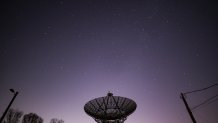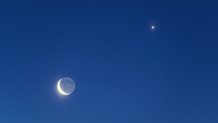Starting this week, astronomers will have many opportunities throughout the year to look up at the skies and see great celestial events.
Nine active meteor showers are predicted this year — best seen after midnight when there’s a new moon — along with several eclipses, different planets visible in the distance, and more.
Here are the dates of visible celestial events for the rest of this year:
April and May: Highlighted by the Lyrid meteor shower
The April Full Moon, known as the Pink Moon, will arrive on April 6. The new moon will arrive on April 20.
The biggest event in the sky in April will be the Lyrid meteor shower, which occurs between April 16 and 25 each year, and is expected to peak on April 22 this year.
The May Full Moon, known as the Flower Moon, will arrive on May 5. Later that same day a lunar eclipse will occur, with parts of the eclipse seen in parts of southern and eastern Europe, Asia, Australia, Africa , Pacific, Atlantic, Indian Ocean and Antarctica.
The Eta Aquarid meteor shower is active between April 15 and May 27 each year. This year, the rain is expected to peak on May 5, which could be one of the busiest days of the year in the sky.
The new moon will arrive on May 19.
June and July: Strawberry Moon
The June full moon, known as the Strawberry Moon, will arrive on June 3. The next day, Venus will reach its greatest angular distance, 45 degrees, east of the sun.
The new moon will arrive on June 18, and June 21 will be the summer solstice in the northern hemisphere and the winter solstice in the southern hemisphere.
Before many Americans light up the skies with fireworks for Independence Day, the July full moon, also known as the “Buck Moon,” will arrive on July 3.
The July new moon will arrive on July 17, which will be the last celestial event of the month.
August and September: two full moons in August
The August Full Moon, known as the Sturgeon Moon, will arrive on August 1. The Perseid meteor shower is active from mid-July to late August each year and is expected to peak on August 11 this year.
The new moon will arrive on August 16. Just over a week later, the moon will pass one of the brightest and most colorful stars in the sky, Antares, on August 24.

Later in the month, on August 30, a second full moon will arrive, known as the Blue Moon because it is the second full moon in a month.
The new moon will arrive on September 14. September 29 will toast to the September Full Moon, known as the Harvest Moon.
October and November: four meteor showers
The Draconids meteor shower will be active between October 6 and October 10 and is expected to peak on October 8. The new moon will arrive later that same day.
An annular solar eclipse will cross North, Central and South America on October 14, followed by the arrival of the new moon later in the day.

The Orionid meteor shower will be active between September 26 and November 22 and is expected to peak on October 20.
The October Full Moon, known as the Hunter’s Moon, will occur on October 28. That same day, a partial lunar eclipse will occur. Parts of the eclipse will be visible in Europe, Asia, Australia, Africa, North America, northern and eastern South America; the Pacific, Atlantic and Indian oceans; the Arctic and the Antarctic.
The South Taurids meteor shower will be active between September 28 and December 2 and is expected to peak on November 4.


The new moon will arrive on December 12. The Geminid meteor shower is active from December 4 to 17. It will reach its peak on December 14.
The Ursids meteor shower will be the last meteor shower of the year and will be active from December 13 to 24. It is expected to peak on December 21.
The last full moon of the year, known as the Cold Moon, will occur on December 26.

